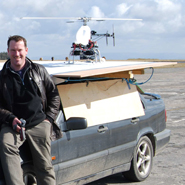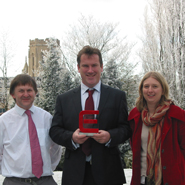An aerospace engineer from the University of Bristol has won a national award for his part in developing new technology which could benefit the emergency services. The auto-landing system technology enables an Unmanned Aerial Vehicle (UAV) to identify a suitable landing area and land without any support from ground-based systems.
Dr Tom Richardson, a lecturer in Flight Mechanics and part of the HUAV auto-landing system team, won the Aerospace category in The Engineer Technology and Innovation Awards, a prestigious awards scheme run by The Engineer magazine. This year’s awards focused on ‘collaboration’ between technology-led companies and universities, or between businesses with distinct areas of expertise.
The project, led by Roke Manor Research, the University of Bristol, aerospace manufacturer MBDA, and UAV specialist Blue Bear Systems, was to develop a method by which an aircraft's position and orientation can be determined using information solely from a camera mounted on the aircraft. This data is then used in conjunction with a flight-control system to automatically land the aircraft. Developing a measurement, processing and control system that achieves this autonomously required a highly innovative use of image-processing techniques.
The system, trialled on Roke's electric helicopter UAV, where it not only demonstrated a successful landing onto a ground target but also onto a moving ground vehicle, is now being developed into a stand-a-lone product for both fixed and rotary-wing vehicles.
The technology could also help the emergency services. For example, mountain rescue teams could use the auto-landing system as it would allow a UAV to recognise and land in a pre-selected area.
Dr Richardson, who led the University of Bristol effort and carries out research in autonomous landing systems, and in a wide range of control systems theory and applications for UAVs, said: “We are thrilled, the award provides national recognition of the innovative work that takes place here at Bristol and in the UAV Dynamics and Control field. Competition within the category was fierce and it is a great credit to all those who were involved at Bristol that we received the award.”

